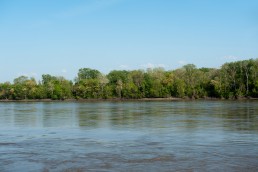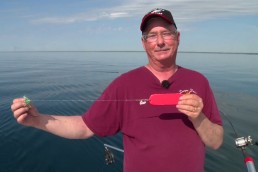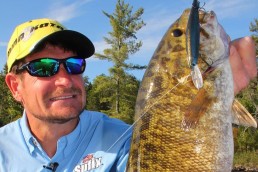Spinnerbait Secrets for Big Spring Smallies
SHARE THIS POST
The pre-spawn period is easily the best time of year to tag a big bronzeback on a spinnerbait. This is largely due to a smallmouth’s tendency to seek out cover in pockets of warm, shallow water in early spring. A percentage of smallmouths are sure to vacate deep water as soon as there is a warming trend of any kind in the spring.
Any time you spot shallow brush, fallen trees, sunken logs, stumps or even flats of reeds, it’s a good idea to make a run through it with a spinnerbait. Rocky shorelines can also be good spinnerbait territory and are particularly good when they contain scattered woody cover. A sandy bottom with a carpet-like grass called elodea is also a magnet for both largemouth and smallmouth bass. Add an occasional sunken log or boulder to this terrain and you have the makings of superb prespawn smallmouth terrain—perfectly suited for spinnerbait fishing.
All of these spots are magnets for crawfish and minnows in the spring. If they are positioned on the north end of a lake, baked by early-season sunlight, it is almost a sure bet that they will hold crawfish, minnows and big bass. I particularly like it when there is some wind and wave action on these spots in the prespawn.
The term, pre-spawn, in this instance, is the period from ice-out until bass start to build nests. This typically occurs in late April and continues into early to mid May in the upper Midwest, when water temperatures are still likely to be lower than 55 degrees. However, the prespawn period often extends well into late May when spring weather remains chilly.
When there’s a good chop (wave action), and a warming trend, don’t be surprised to find packs of smallies just off the bank cruising over the rocks in search of minnows and crawdads. Any kind of subtle point or protrusion of rocks or gravel is likely to be a hotspot for several fish. The best casts with a spinnerbait here are actually right up near the bank. In this situation, using baitcasting gear, I like to pitch the spinnerbait with a side arm underhand roll cast. It keeps the trajectory of the lure very low—just off the water’s surface—so you can see it traveling toward the bank. Because the lure contains an up-riding single hook, it rarely gets snagged, especially if you maintain a tight line.
Are you enjoying this post?
You can be among the first to get the latest info on where to go, what to use and how to use it!
Keep fishing ahead of the boat with casts somewhat parallel, so you can test both the shallowest cover near the bank as well as submerged targets offshore on extended flats. Always be on the lookout for something different as you move along an area, using your vision combined with good polarized sunglasses. Keep scouting for targets. Fish might be holding in woody cover of some kind, or a patch of weeds, but don’t be surprised if a slightly larger rock or a big boulder holds a lunker. Dark spots on sandy flats can be the most underrated spot of all. They are usually patches of grass that hold minnows and crawfish. Groups of big bass can often be caught from spots like this.
Retrieve speed should always be considered, but you will generally find that smallmouths really like a hot spinnerbait. In other words, one that’s burning just under the surface—even when the fish are hunkered tight in cover far below it. Surprisingly, smallies will roar up and smash a high-riding spinnerbait, even in gin-clear water. The clearer the water, the more they are apt to trigger on a high-riding spinnerbait that is being burned back. Some of the most incredible strikes will occur with this technique. Honestly, I think a big bronzeback hits a spinnerbait harder than a muskie does when you work it this way.
The most popular spinnerbait colors today often mimic shad and shiner patterns. Yet, I’ve had far more success with bronzebacks using bright chartreuse colors, including painted blades, over metallics. I’ve demonstrated this chartreuse color thing with smallies many times on my TV show over the years. For some reason, smallies really go nuts after chartreuse spinnerbaits with chartreuse blades. I am not saying they won’t hit traditional largemouth patterns like shad, shiner and white combinations, but nothing catches ‘em quite like chartreuse. In fact, I think they also hit the chartreuse pattern harder! I have fished behind guys many times, who insisted on subtly slow-rolling a shiner pattern spinnerbait with tandem metal blades, only to have me follow up behind them, burning a chartreuse single spin, and get smoked. As soon as they switch to the chartreuse and pick up the speed, they start catching ‘em. This is perhaps where traditional bass fishing with spinnerbaits for largemouths differs most from that of casting the same lure category for smallies. Smallies like color and speed!
The secret is out. Spinnerbaits are hot for big prespawn smallies. Don’t miss out on this great action-packed opportunity. Big bronzebacks can be very aggressive at this time of year, so there’s no need to fiddle around with light tackle and dainty baits. Tie on a chartreuse spinnerbait, get upwind of a good-looking spot and start chunkin’. Don’t be surprised if your rod nearly gets yanked out of your hand as your spinnerbait burns across a good-looking spot. The first time you experience this, you’ll know exactly what I’m talking about.
Editor’s note: MidWest Outdoors welcomes back into the fold legendary Hall of Famer Joe Bucher…Expect more great fishing advice from one of our region’s truly great fishermen, and teachers. And by the way, he plays a truly mean guitar as well.
MWO
SHARE THIS POST
Did you enjoy this post?
You can be among the first to get the latest info on where to go, what to use and how to use it!
Joe Bucher
Joe Bucher is a Freshwater Fishing Hall of Fame Legendary Angler, book author, lure designer and host of Fishing with Joe Bucher TV series.



